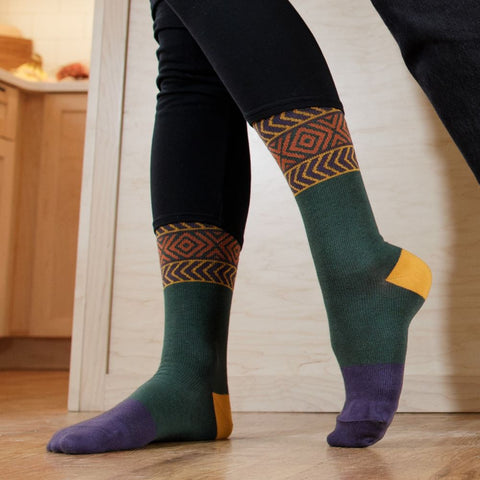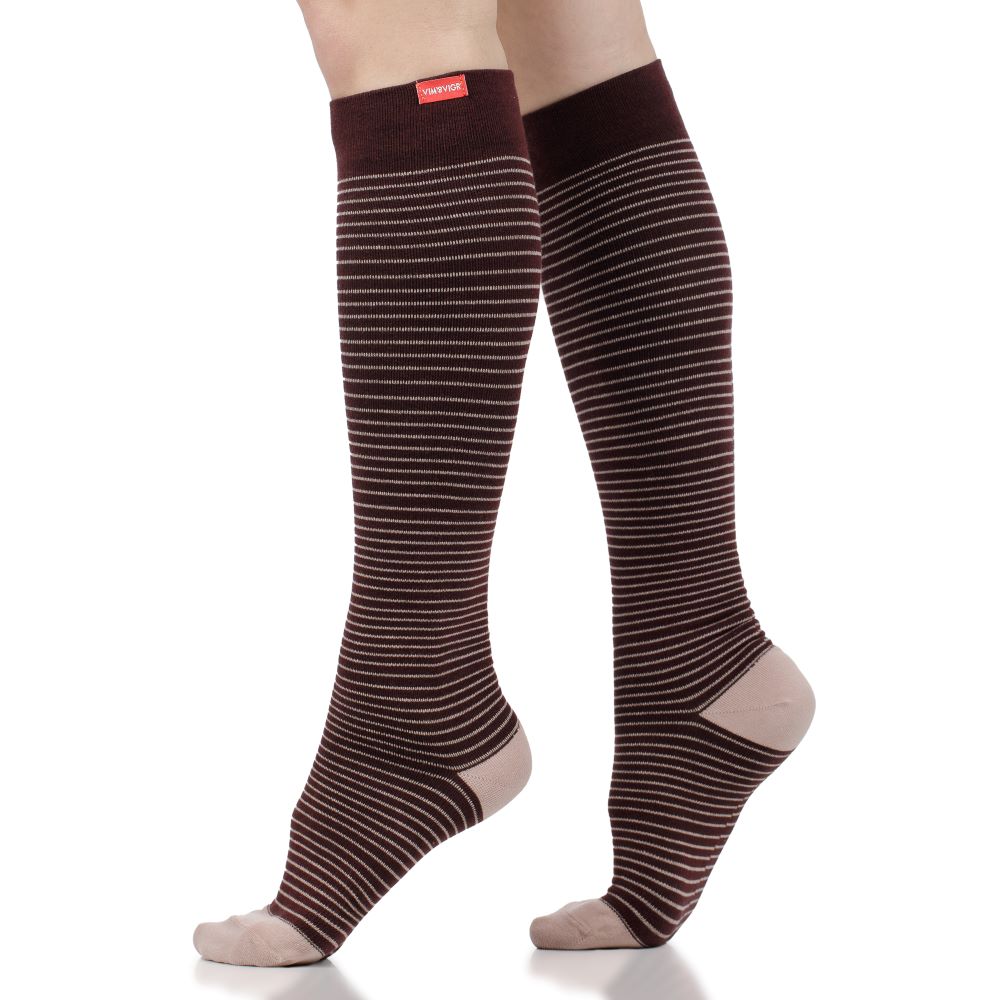Walking for Swollen Legs: Why It Works & How to Get Relief
Scientifically Reviewed by Daniel Chantigian
In this article, we’ll focus on why walking is so beneficial for those suffering from swollen legs. Find out how to manage your leg health and what complementary strategies work with walking to better reduce leg swelling.
Does Walking Help Swollen Legs?
Exercise is essential for keeping your heart and muscles healthy. Exercise helps you keep healthy blood flow and can help others improve blood flow, which will reduce the risk of your legs swelling. It helps you maintain a healthy blood flow, which reduces the risk of your legs swelling. This is because fluid has built up in your legs due to the effects of gravity. Walking can counteract this, and walking is also a gentle way to start exercising if you have not exercised for a long time.
However, it’s important to understand that walking or running have also been found to lead to leg swelling in people with edema right after exercise, as this study suggests. But it was just a 1.4% increase in fluid, and the study did not discuss the long-term effects of walking. When choosing to walk for fitness, you need to consider how your overall health condition can influence the risk of edema and what the best options are for you (by consulting with a medical professional).
How Walking Helps Swollen Legs
Walking is great for reducing the swelling in our limbs since it helps stimulate blood flow while building muscle strength and cardiovascular fitness. Stronger muscles support the circulatory system by improving blood flow, as reported by one research study. Additionally, a key study states that movement, like walking, is essential for draining lymph fluids to reduce leg swelling. Here are 3 ways in which walking helps reduce leg swelling and keep leg swelling down.
Improves Circulation
The feeling of “pins and needles” or numb legs and feet can happen when we sit or stand for long periods of time. This uncomfortable feeling is linked to poor blood flow in our limbs. This is caused by gravity making upwards travel of blood more difficult and the pressure on your blood vessels from the fluid buildup thanks to gravity. Poor peripheral circulation can cause blood and other fluids to pool around the ankles, leading to swelling and discomfort.
When you go for a walk, your leg muscles are pumping to help blood and other fluids flow out of the swollen legs. Over the long term, walking builds more muscle strength of your calves and leg muscles, which helps support the pumping of fluid and blood out of the legs. This helps circulation in the veins and the lymphatic system and reduces the risk of blood and lymphatic fluid pooling in the lower limbs.

Enhances Lymphatic Drainage
Your leg muscles support fluid flow through the veins and the lymphatic system. Flow of fluids out of your legs is stimulated by movement. The contraction of muscles effectively pumps fluid through the body, which helps prevent leg swelling.
Stimulates Muscle Movement
In addition to benefits for the circulatory and lymphatic system, walking is also a gentle and simple way to build muscle strength, release tension and stress, and include some exercise into a busy daily routine. It is easier on the joints than more high-impact activities like running, which is why it’s an accessible way to stay active and reduce leg swelling.
How to Start Walking to Manage Leg Swelling
If you are prone to having swollen legs and ankles, walking can be a great first step to help find relief and to reduce the risk of developing swollen legs again. But, just as with any form of exercise, don’t overdo it and consider your safety.
Start Slow and Gradually Increase Intensity
The first rule with every new activity is to pace yourself. Walking too quickly or too much at the start can increase the risk of injuries, from painful inflammation to stress fractures. Start by walking 20-30 minutes, at an easy pace. Once you’re comfortable doing this 2-3 times a week, you can increase the duration of your outings by 5-10 minutes at a time.
You can also split your walks into “easy” and “intense” ones later. For example, go for a 2-hour easy walk in the park with your family at the weekend. During the week, take one of your walks at a quick pace, but keeping duration to about 40 minutes. Your heart rate will increase, which will be great for stimulating blood flow and building your fitness.
Find a Suitable Walking Surface
For beginners, walking on soft surfaces is the best way to start. Ideally, softer is better - so going to a park where you can walk on grass or dirt tracks is preferable. The softer landing surfaces are better for your joints and will make the whole experience more enjoyable. However, if you don’t live near trails or parks, roads or sidewalks also work great, but start on flatter surfaces to avoid putting too much pressure on your muscles and joints.
Later, when you’ve built your fitness levels, start walking on hilly routes to get increases in muscle strength and improvements to your cardiovascular fitness.
Wear Supportive Footwear
Avoid injuries like Achilles tendonitis or shin splints by wearing proper walking shoes. These can be regular running shoes designed for the road, if you’re walking in an urban environment, or walking or trail running shoes for off-road conditions. If you venture onto dirt tracks and trails, choose shoes that have ankle support and good grip on their soles to prevent slipping and sliding.

Incorporate Walking Into Daily Activities
An easy way to increase your activity levels is to make walking a seamless part of your routine. For example, park your car a little further away from the store or the office, and walk a little longer to get to your destination. If you’re going somewhere that can be reached on foot, block a longer time slot in your diary to allow you to get there by walking.
To help you digest better, you can also make a 10-minute walk part of your lunch break. Go and stretch your legs with a short wander after you’ve eaten.
Finally, for those who work from home - create a “fake commute” to clear your mind and separate out the time you spend “at work” from the rest of your day. Get out of the house and walk for 5-10 minutes every morning before you sit at your desk. In the evening, do the same thing once you’ve switched off your computer. Before you know it, this will become the norm and increase the time you spend moving while giving yourself a well-deserved break from screens.
Complementary Strategies to Help Leg Swelling
Walking can help you cope with swollen legs and ankles, but there are extra things you can do to manage these symptoms more effectively, especially if the swelling gets more severe.
Wear Compression Socks
Older adults or less mobile people can boost their peripheral circulation and improve comfort of their lower legs by wearing compression socks. Studies also show that wearing compression legwear while walking helps reduce swelling even more than walking with normal socks (they also prevent swelling when walking in people with edema).
If you can’t walk regularly, wear graduated compression socks as much as possible. They stimulate circulation of fluids out of the legs and also prevent blood clots and deep vein thrombosis. This is especially important when you are flying or driving for long periods of time.
Finally, compression socks are very effective at helping with recovery after exercise, delivering nutrients and oxygen to the muscles and massaging the limbs to relax them. That is why they can be excellent accessories to support a walking program, too.
Modify Your Diet and Lifestyle
Very often, damage to the veins is caused by an unhealthy lifestyle, and this can lead to narrowing of the blood vessels and impaired circulation to cause leg swelling. Additionally, consuming too much salt in your diet can also lead to water retention and swelling.
To boost your circulation and improve your overall well being, pair walking with a healthy diet full of fresh fruits and vegetables. Ensure you stay properly hydrated, too - avoiding cramps and helping blood flow freely throughout the body.
Seek Medical Advice for Underlying Conditions
No matter how well you manage your leg swelling with walking and complementary strategies, it’s important to check in with your doctor to rule out any serious medical implications. Additionally, seeking medical advice can help make connections between your leg swelling and other conditions, e.g. lipedema. Your doctor can also give you more tips about how to exercise safely.
References
Sharma, S., Merghani, A., & Mont, L. (2015). Exercise and the heart: the good, the bad, and the ugly. European heart journal, 36(23), 1445–1453. Read it here.
Anton, M. M., Cortez-Cooper, M. Y., DeVan, A. E., Neidre, D. B., Cook, J. N., & Tanaka, H. (2006). Resistance training increases basal limb blood flow and vascular conductance in aging humans. Journal of applied physiology (Bethesda, MD: 1985), 101(5), 1351–1355. Read it here.
Li, Y., Meng, Q., Luo, B., Li, M., Fang, J., Allred, S. R., & Fu, M. R. (2023). Exercises in activating lymphatic system on fluid overload symptoms, abnormal weight gains, and physical functions among patients with heart failure: A randomized controlled trial. Frontiers in cardiovascular medicine, 10, 1094805. Read it here.
Stanek J. M. (2017). The Effectiveness of Compression Socks for Athletic Performance and Recovery. Journal of sport rehabilitation, 26(1), 109–114. Read it here.


















Leave a comment